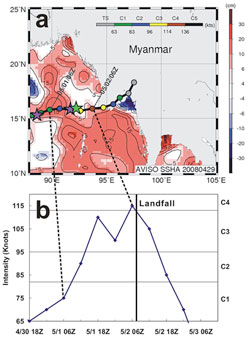News | March 18, 2009
Seeds of disaster
One of the things that made Nargis so deadly was the way in which it intensified so quickly before making landfall -- from a category-1 to a category-4 tropical cyclone in just 24 hours. But how exactly did this happen? New research suggests that abnormally warm waters off the coast of Burma in the Bay of Bengal played a major role.
Working alongside researchers in Taiwan, W. Timothy Liu of NASA's Jet Propulsion Laboratory in Pasadena, Calif., analyzed ocean depth and temperature readings that had been collected by floating devices at sea and by satellites such as NASA's Jason-1 ocean surface topography mapper. They found that, around the time of the cyclone, the waters near Burma contained an unusually warm layer 100 to 200 meters (about 109 to 219 yards) deep. The extra energy in this layer meant that the atmosphere above the ocean was "fed" with three times as much heat, enabling Cyclone Nargis to intensify so rapidly. While the Burma tragedy cannot be undone, Liu and colleagues hope that the work will help to improve forecasts of future cyclones in the Northern Indian Ocean, which are notoriously hard to predict.
The results appear in Geophysical Research Letters.
| Research paper: |

